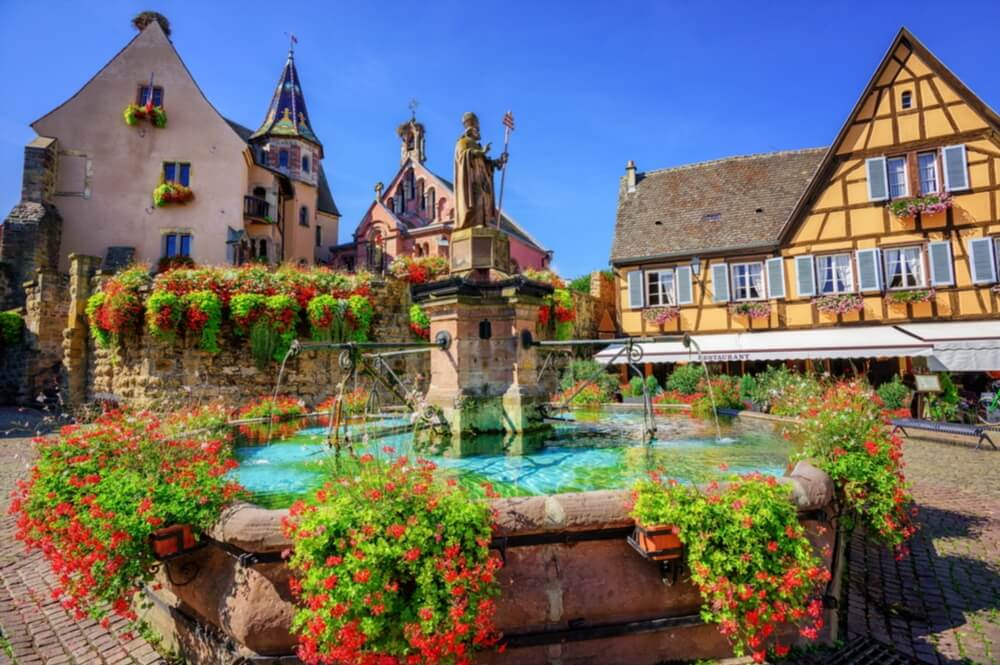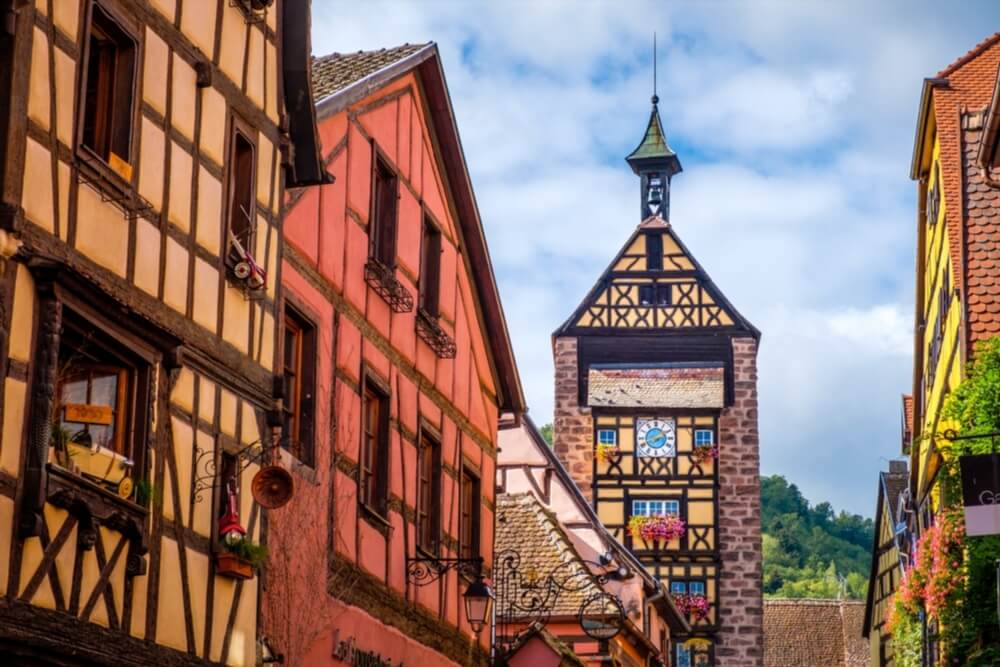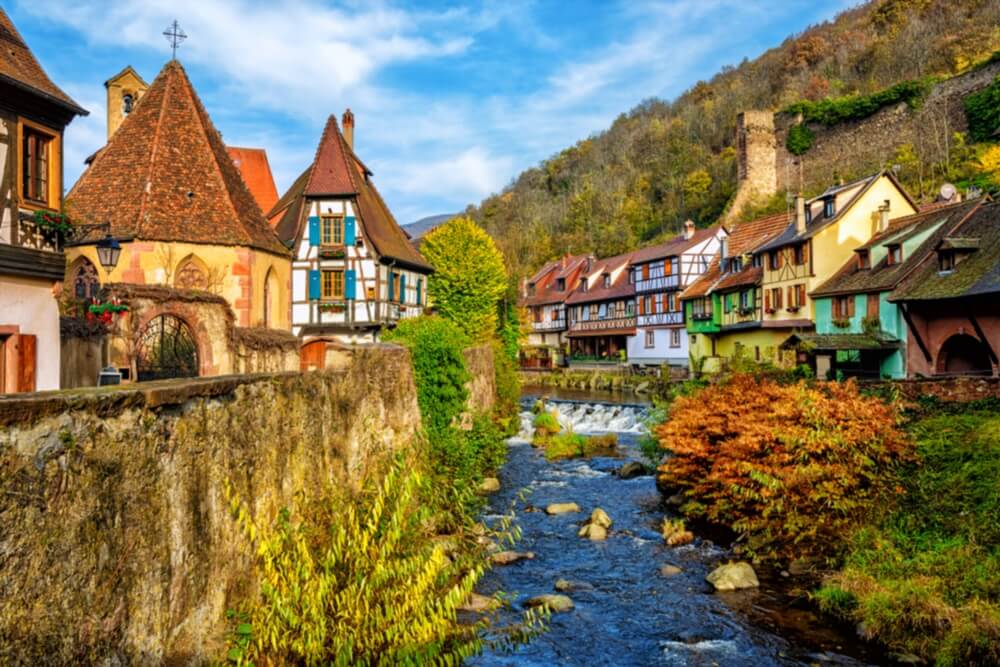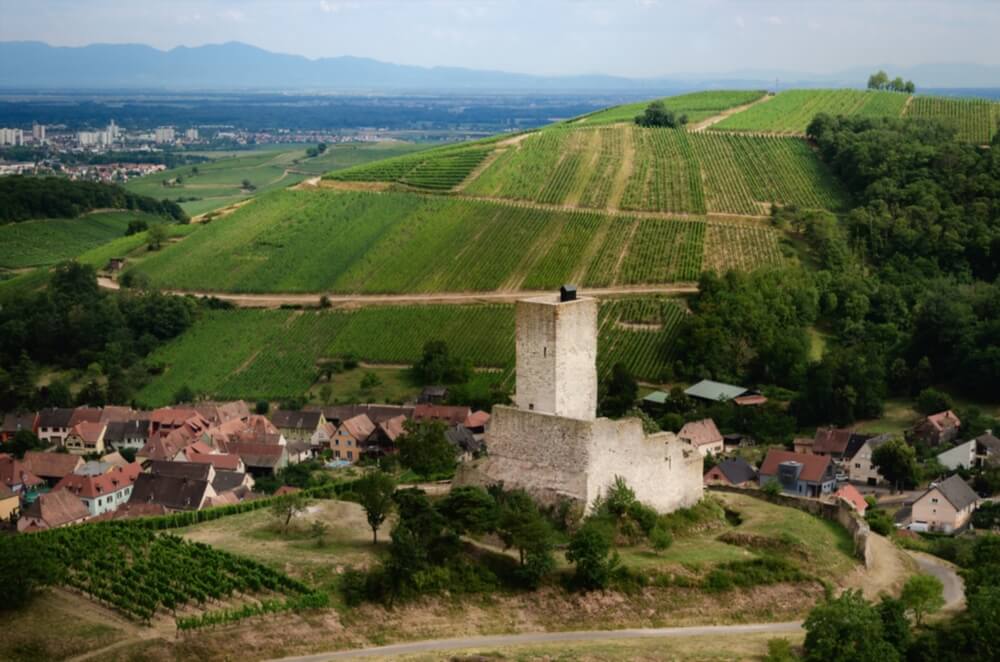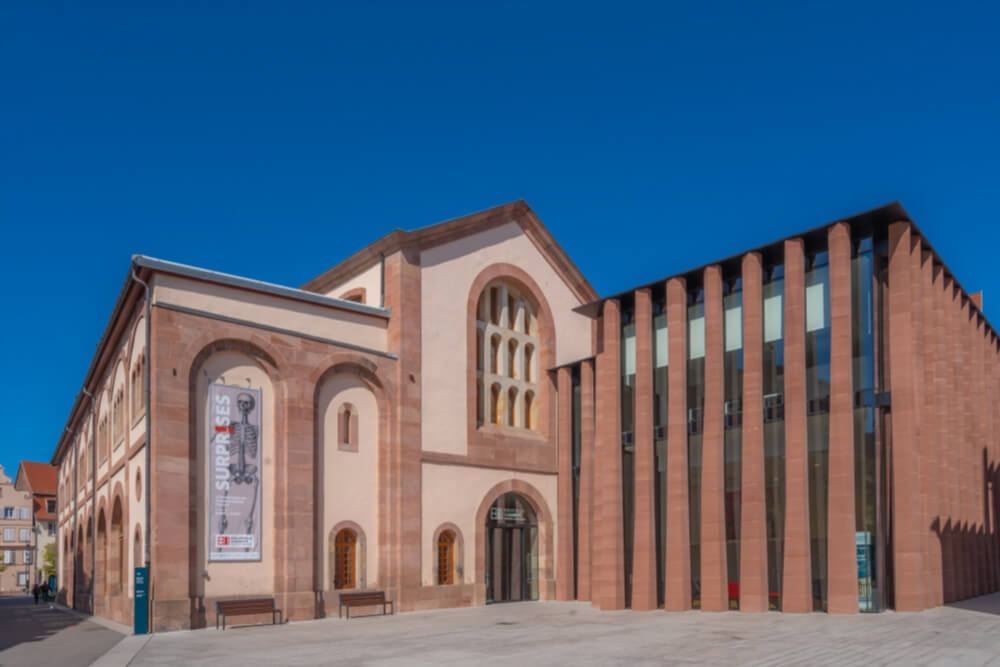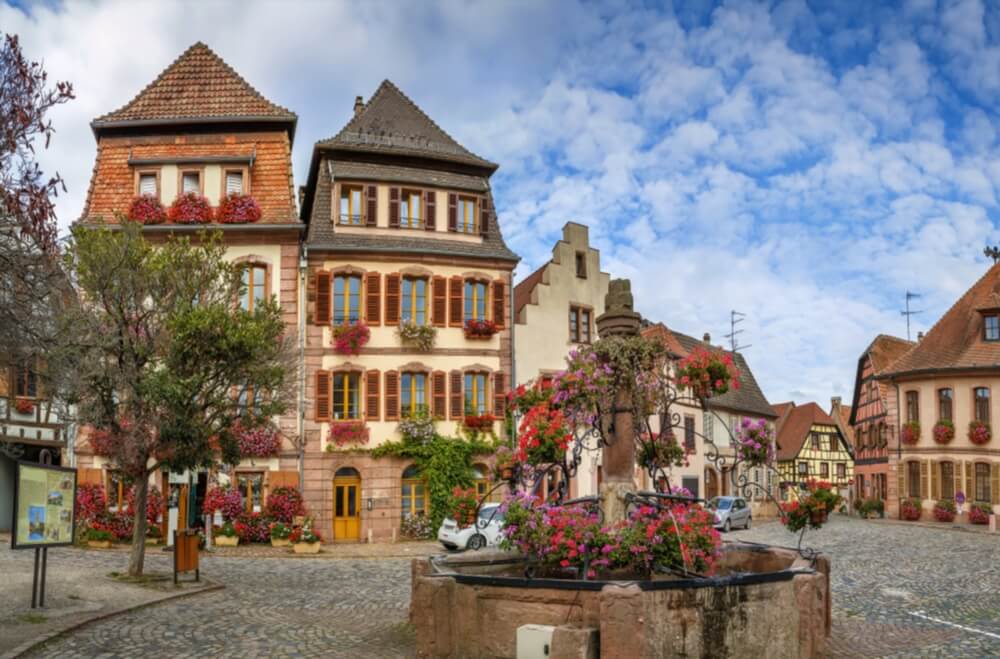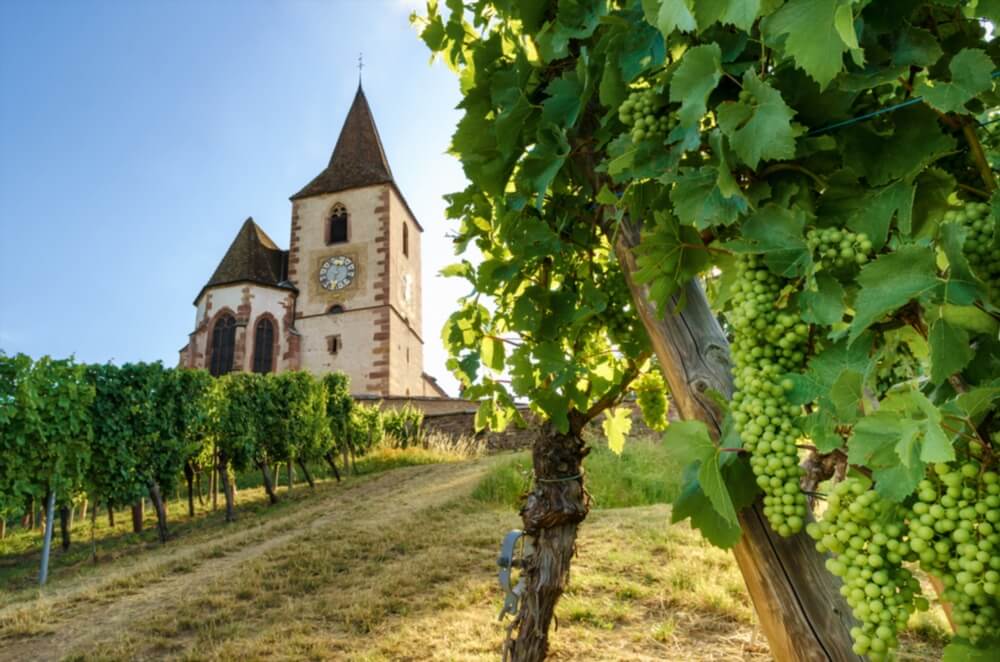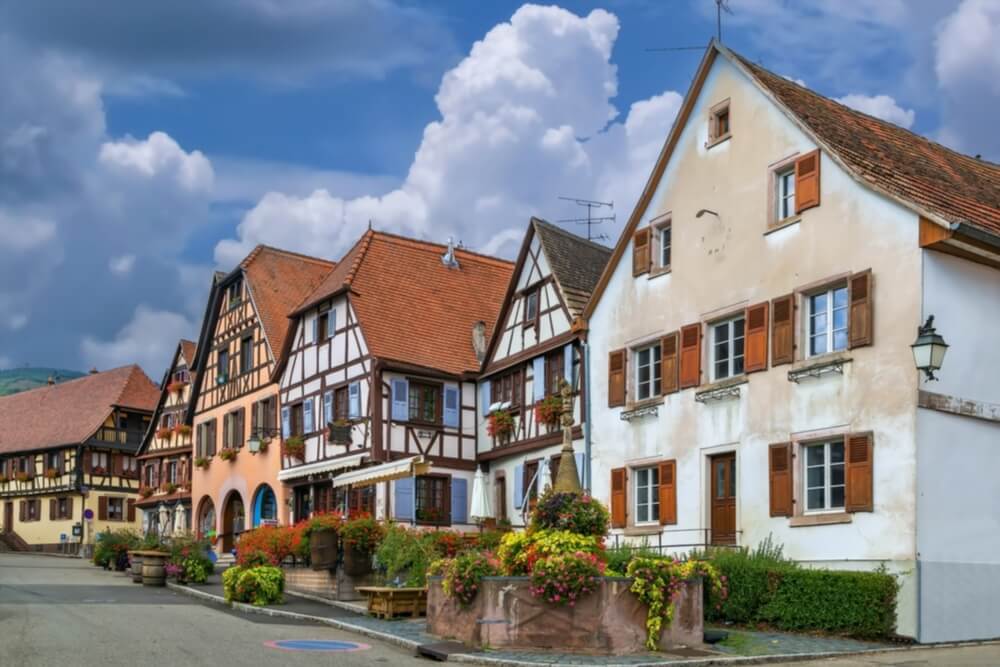10 Alsace villages to discover near Colmar

1. Eguisheim
This wine-growing commune in the Haut Rhin, surrounded by hills planted with vines, is famous the world over. It is listed as one of the most beautiful villages in France and has won numerous awards for its flowers. The Winegrowers’ Festival on the last weekend in August is a traditional celebration not to be missed, with wine tasting, folk entertainment, a dance, a grand procession and traditional food!
What to do in Eguisheim
Medieval houses
Strolling through the streets of Eguisheim, admiring the half-timbered houses and colourfully carved stonework, is a really enjoyable experience. If you’re a keen photographer, you’ll be sure to get a great shot! The authentic, unspoilt charm of north-eastern France, perfectly maintained, with unique architecture and a town that spreads out in concentric circles around its castle.
What to see
The castle, the fountains, the colonial courtyards, the neo-Romanesque chapel of Saint-Léon IX, the church of Saint-Pierre and Saint-Paul, the stork park…
Wine
Summary: 27 estates are active in Eguisheim on the Alsace wine route.
Eguisheim was voted French Favourite Village in 2013.
2. Turckheim
This medieval town, formerly an imperial city, boasts a large number of colourful, flower-filled half-timbered Alsatian houses, as well as a noteworthy architectural and wine-growing heritage.
What to do in Turckeim
Renaissance houses
Testimony to the rich history of the wine trade in the 16th and 17th centuries, a number of fine residences were built during this period, as well as the Town Hall and the Guardhouse.
The medieval town
In addition to the half-timbered houses, you will also discover 3 gates, evidence of the old fortifications: The Porte de Munster, the Porte du Brand and the Porte de France.
The church of Saint Anne
This 5-storey vestige of Romanesque art houses 4 bells (D, E, F, A), a drone, a Silbermann organ built in 1755 and many other treasures: paintings, stained-glass windows, statues and a piéta.
What to see
- The night watchman, an ancestral tradition maintained until 1939 and revived in 1953. His footsteps and song echo through the streets of Turckheim from 1 May to 31 October during his 10pm rounds.
- The Musée Mémorial des Combats de la Poche de Colmar.
- A 17th-century town hall that was once the seat of the court of justice of the former imperial town.
Wine
Legend has it that a dragon was built against the sun, and that ever since, this land of fire has been producing majestic wines of sublime delicacy… Something to check out with the 11 local producers!
3. Riquewihr
Listed as one of the most beautiful villages in France, this “pearl of the vineyards” welcomes almost 2 million tourists a year to its typical houses and historic monuments.
The Dolder
This 12th-century gateway was once a defensive tower, a watchtower and a belfry. Today it houses a museum presenting a fortified wine-growing town from the Middle Ages and its development from the 13th to the 17th century.
Thieves’ Tower Museum with Winegrower’s House
A defensive tower with a 13th-century parapet walk, the 16th-century winegrower’s house and its period decor. Also worth seeing is the temporary exhibition.
The Place des Trois Églises
3 churches dating from the 12th and 14th centuries: a parish church, a pilgrimage church and a church linked to the nearby hospital. You’ll be able to see large arcades, murals, etc.
What to see around Colmar
- The 14th-century castle of the Counts of Montbéliard-Wurtemberg.
- The Museum of Communication located in the castle
- The Sinne fountain, once used by winegrowers, is topped by a lion.
- The Hansi House in Riquewihr, with watercolours, lithographs, advertising posters, postcards and crockery decorated by the artist.
- The Féerie de Noël shop, where you can visit Santa’s workshop.
4. Kaysersberg
Kaysersberg is famous for its authentic Christmas market. The town is transformed into a magical place. Kaysersberg was also voted “Favourite Village of the French” in 2017!
The old village
The original medieval fortifications have survived, and you can discover them as you stroll through Kaysersberg, along with the ramparts, the half-timbered houses and the fortified bridge that links the lower and upper parts of Kaysersberg. Off the main roads, don’t hesitate to get lost in the rue des pottiers, the rue de la commanderie, the rue de l’ancienne gendarmerie, the rue du couvent…
Kaysersberg Castle
Visible from the town, this 13th-century fortified castle is now no more than a vestige, but it offers a magnificent view of the vineyards, the Alsace plain and the Vosges mountains from the top of this hill.
The parish church of Sainte-Croix
Built in the 13th century, you’ll be impressed by the 4.25-metre-high statue of Christ, with those of the Virgin Mary and Saint John, each 2.06 metres high, beside it, and by the superb 16th-century altarpiece depicting the Passion of Christ in 14 paintings.
What to see
- The Albert Schweitzer Museum traces the life of this philosopher, theologian, musicologist and organist.
- The Musée du Vignoble et des Vins d’Alsace: the origins and skills of Alsatian winegrowers, and the Alsace wine route.
- The town’s historical museum: local customs, legends and stories will no longer hold any secrets for you.
- The Badhus: a seventeenth-century building that has always played an essential role in Kaysersberg’s economic fabric, from municipal baths to a wine-buying centre, this site is now an essential exhibition and reception hall for the town.
5. Katzenthal
This village is famous for its vineyards, but it also has a few places of interest.
- The 13th-century Château du Wineck, where an association is working to revive the building and its history, which have been neglected for far too long, and in particular the 21-metre-high keep. Archaeological remains can also be seen.
- The church of Saint-Nicolas is home to a 19th-century organ and a superb ciborium (sacred vessel).
- Mountain-biking and hiking trails and wine-tourism routes, with tasting breaks and visits to wine cellars, all set against a superb backdrop.
6. Sélestat
The capital of humanism during the Renaissance, then a garrison town under Louis XIV, Sélestat has many monuments to visit. It has also been awarded the Ville d’Art et d’Histoire (Town of Art and History) label, making it a very pretty town to stroll around on holiday, while taking advantage of the many activities on offer.
- The church of Saint-Georges boasts magnificent 15th-century stained glass windows.
- The Tour des Sorcières on the Place de Lattre de Tassigny, a 13th-century tower used as a prison for witches in the 17th century.
- The Porte de Strasbourg (Vauban fortification), the only vestige of the old 17th-century fortification.
- The 13th-century Tour Neuve features 15th-century frescoes (scenes of hunting, grape harvests, etc.).
- The 11th-century crypt of Sainte-Foy church contains a cast of the death mask “La belle inconnue de Sélestat”.
- The timber-framed houses on the Quai des Tanneurs were built during 3 distinct periods: the Middle Ages (late 13th and 15th centuries), the Rhenish Renaissance (15th and 17th centuries) and the 18th century.
- The Arsenal Sainte-Barbe, a 15th-century Gothic building where you can visit temporary exhibitions.
- The municipal baths, built in 1927, have been converted into a music school, but the original ornaments and bas-reliefs remain.
- The splendid 50-metre-high water tower, built in 1906, with its peppered roof.
- The Rue des Chevaliers, which is partly pedestrianised, is one of the oldest streets in the town and is home to numerous shops and terraces.
- Humanist Library: 460 manuscripts, 6,400 very valuable works printed between the 15th and 16th centuries.
- …
7. Bergheim
A typical village on the wine route, encircled by its ramparts. Many of the winegrowers’ houses are still in excellent condition, with views over the vineyards and Haut-Koenigsbourg castle.
- The Porte Haute (High Gate): built in the 14th century, this guarded the western entrance to the town.
- The ramparts walk: it surrounds a large part of the village and offers beautiful panoramic views of the moat, the half-timbered houses and vineyards, the surrounding towers, the vineyards and Haut-Koenigsbourg castle. A visit not to be missed.
- The 14th-century church with its frescoes, nave and Tuscan columns.
- The former ossuary housing the town’s Museum of Art and History.
- The Grand-Rue and its old wash-house.
- The Witches’ House.
Bergheim is one of the most beautiful villages in France around Colmar.
8. Hunawihr
Enjoy a 360° panoramic view of the vineyards and the Vosges mountains from this tiny village, listed as one of the “Most Beautiful Villages in France” thanks in particular to its fortified church.
- The 15th-century church of Saint-Jacques le Majeur, surrounded by a fortified cemetery.
- Winegrowers’ houses from the 16th and 18th centuries.
- The Sainte-Hune fountain and the wash-house on the Place du Sinn.
- The old weaving mill.
- The coats of arms: cooper, gourmet, baker, etc.
- Naturoparc, a wildlife park where you can see storks, otters and large hamsters.
- The butterfly garden.
9. Dambach-la-Ville
A medieval wine-growing town with brightly-coloured houses. What to do in Dambach-la-Ville?
- Hiking, including a wine trail where you can discover the local wine nearby.
- 3 fortified gates and a surrounding wall encircling the village.
- The Saint-Sébastien chapel with its Romanesque tower, Baroque high altar and 12th-century ossuary.
- Visit the wine cellars in the village and taste the Grand Cru Frankstein.
10. Ribeauvillé
Dominated by the castle of Saint Ulrich, Ribeauvillé is a town with a rich historical heritage where life is good.
- The minstrel festival with its floats, held on the 1st weekend in September, is the oldest traditional festival in Alsace, dating back to the 14th century. Very popular in Alsace.
- The 3 castles hiking trail: St-Ulrich, Girsberg and Haut-Ribeaupierre.
- The Town Hall exhibits a collection of silver Hanaps (drinking cups) inherited from the Counts of Ribeaupierre.
- The Butchers’ Tower (13th century).
- The old wheat market, a former storage area.
- The uniquely decorated 17th-century minstrels’ house.
- The Grand’rue, with its typical quarters and Renaissance-style fountains.
Also worth a visit
Neuf Brisach is one of the 12 towns in the network of major Vauban sites, and has been on UNESCO’s World Heritage List since 2008. A true Alsatian jewel, it also hosts a festive event every summer in its foothills: the Neuf Brisach festivities. Another exceptional village near Colmar in Alsace.
200 audioguided tours for cities all around the world
Download